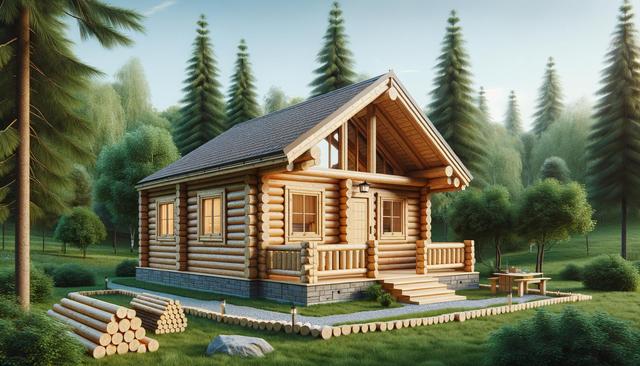What Are Ready to Assemble Log Cabin Kits?
Ready to assemble log cabin kits are pre-manufactured packages that include all the necessary materials to construct a log cabin. These kits typically come with pre-cut and pre-measured components such as logs for walls, floor joists, roof trusses, and sometimes even windows and doors. Designed for ease of use, these kits cater to those who wish to build a cabin without starting from scratch. Assembly is guided by detailed instructions and often requires only basic tools and a few helping hands. This makes them a practical choice for both first-time builders and experienced DIY enthusiasts looking to streamline the construction process.
The growing popularity of log cabin kits can be attributed to their convenience, cost-effectiveness, and the rustic charm they offer. Unlike traditional construction, the assembly process is significantly faster, reducing labor costs and minimizing construction waste. For many, it’s also a rewarding experience to be hands-on in the creation of their own retreat or guest house.
Benefits of Choosing a Log Cabin Kit
One of the most attractive aspects of ready to assemble log cabin kits is the combination of simplicity and customization. While the kits are standardized to some extent, many suppliers offer configurable options to suit different preferences and site conditions. This flexibility allows buyers to adapt the cabin to their specific needs without the higher costs typically associated with custom builds.
Key benefits include:
- Time efficiency: Most kits can be assembled in a matter of days or weeks depending on size and complexity.
- Cost savings: Pre-cut materials reduce waste and labor costs, making the project more budget-friendly.
- User-friendly: Clear instructions and organized labeling make assembly manageable for non-professionals.
- Eco-conscious: Many kits use sustainably sourced wood and efficient building practices.
These features make log cabin kits an appealing solution for vacation homes, backyard offices, or even small-scale permanent residences. Additionally, because many kits meet local building codes, the permitting process is often smoother compared to fully custom construction.
Planning and Preparation
Before investing in a log cabin kit, it’s important to conduct thorough planning. Site selection is critical, as access, terrain, and local climate will influence both the design and the assembly process. A flat, well-drained area is ideal for most kits, and it’s advisable to prepare the foundation in advance—whether it’s a concrete slab, pier system, or crawl space platform.
Other key preparation steps include:
- Checking local building codes and obtaining necessary permits.
- Choosing the right size and layout based on intended use.
- Ensuring access to utilities if needed, such as water, electricity, and septic systems.
- Coordinating delivery logistics to avoid delays or damage to materials.
Proper planning not only ensures a smoother build but also helps avoid unexpected costs. Many kit providers also offer support during the planning stage, helping buyers select the appropriate model and understand the site requirements.
The Assembly Process
Assembling a log cabin kit is a step-by-step process that generally begins with laying the foundation and progresses through stacking the walls, installing the roof, and finishing the interior. Depending on the size of the cabin and the number of people involved, the project can often be completed with minimal professional assistance.
Typical assembly steps include:
- Foundation preparation and base installation.
- Wall log stacking and securing.
- Roof truss installation and sheathing.
- Window and door fitting.
- Interior finishing, including flooring, insulation, and electrical if applicable.
While some homeowners choose to complete the entire build themselves, others may hire contractors for specialized tasks such as electrical work or plumbing. Regardless of the approach, the assembly process is usually faster and more predictable compared to conventional construction, thanks to the pre-cut and labeled parts.
Customizing Your Log Cabin Kit
Though log cabin kits are designed for standardized assembly, there are several ways to personalize them. Buyers can often select from different wood species, roof styles, and floor plans. Some kits also allow for upgrades such as extended porches, loft spaces, or additional windows for enhanced natural light.
Common customization options include:
- Exterior finishes: stain colors, trim styles, and roofing materials.
- Interior layouts: open floor plans, partition walls, or storage lofts.
- Functional features: fireplaces, skylights, or built-in shelving.
- Energy efficiency: upgraded insulation, double-pane windows, and solar panels.
These modifications make it possible to create a space that feels unique and tailored to your lifestyle, whether it’s a cozy weekend getaway or a full-time residence. Additionally, many kit providers are open to special requests, allowing further personalization within the scope of the kit’s design structure.
Conclusion: A Practical Path to Cabin Living
Ready to assemble log cabin kits offer a practical, engaging, and cost-effective way to build a rustic retreat or functional space with relative ease. By combining pre-engineered materials with straightforward assembly instructions, these kits make cabin ownership accessible to a wider audience. Whether you’re seeking a peaceful escape in nature, a backyard studio, or a unique guest house, a log cabin kit can provide a fulfilling and achievable building project.
With proper planning, a clear understanding of the assembly process, and a vision for customization, these kits can be transformed into beautiful, long-lasting structures that serve a variety of uses. For those who value craftsmanship, efficiency, and the charm of traditional timber design, log cabin kits are a worthwhile consideration.


